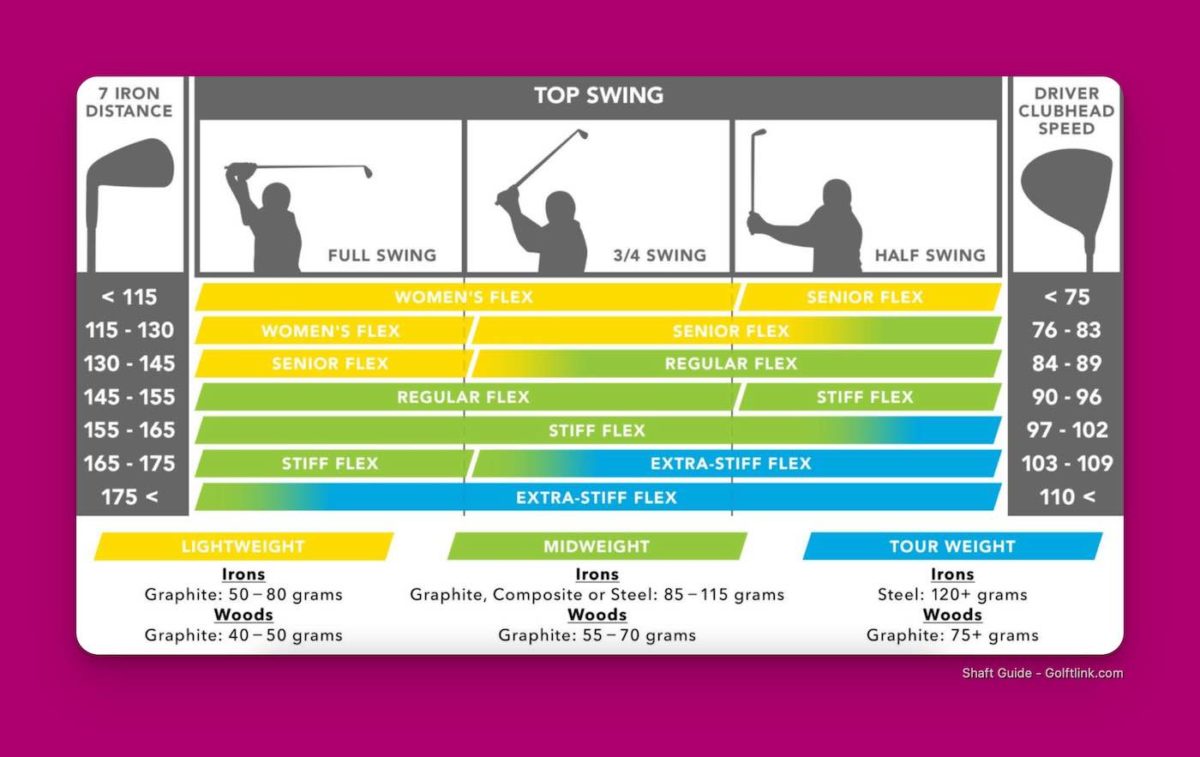On the green, we all want to be able to hit the golf ball as far as we possibly can, and as accurately as we possibly can. What type of golf shaft we use actually has a lot of influence over how we achieve this.
You can find the best shaft that will improve your game at a professional club fitting shop, and you can find such shops at your local country club as well as a mall.
They will probably ask you to choose between a stiff or regular flex driver.
When picking a stiff or regular flex driver, it’s important to keep in mind that the shaft you select may be different to the shafts of your irons.
Usually, you’ll swing a driver with a wide arc, while you hit your irons with a shallower swing. This may be why you find yourself hitting a driver better than you do your irons, or maybe the other way around.
But which driver is going to improve your game? A stiff driver or a regular flex one?
Below, we’ll cover all the key differences between these two types of drivers and how you can find out which driver is the best one for you.
Key Differences Between Stiff Drivers And Regular Flex Drivers
Before we get into whether you should use a stiff driver or a regular flex driver, let’s take a look at how drivers and irons are set up and their different requirements.
Firstly, drivers and irons are different sizes, with drivers having a bit more loft than an iron, so your swing should aim to hit the ball as high as possible. You can use either a stiff shaft or a regular flex shaft for a driver.
A stiff driver is, of course, a shaft with little to zero flexibility, but a regular shaft is more flexible. Stiff flex shafts are normally larger and heavier.
If your golf club was a vehicle, then the shaft would be the engine. The power behind your swing is created in the shaft, and it then travels through the head of the club to create a powerful swing.
Shafts that are flexible and light will make the driver more powerful, and will cause premature whip-around that covers larger distances than you anticipated.
Meanwhile, a stiff shaft will slow the whip down, and you will achieve less distance.
Types of Golf Shafts and Their Stiffness
Since every golf player will require a different kind of stiffness for their drivers, stiffness is categorized into five different types.
These are:
- stiff
- extra-stiff
- women’s
- regulars
- seniors
The right stiff or flexible shaft for a driver can be selected with the assistance of a club-fitter. They will determine what kind of shaft a player needs by having knowledge of the swinging capabilities and how much distance a driver can achieve.
You don’t have to use one shaft for every club, whether that be a stiff shaft or a regular shaft. All clubs play different roles in your game, and therefore require different shafts.
For example, you may prefer a staff that is stiffer for a 7-iron, but have more success with a driver that has a flexible shaft.
If you’re an amateur or recreational player, the general rule is to play with a golf shaft that is flexible for shots with longer distance and a shaft that is on the stiff side for all other shots.
However, your swing speed also factors into this. If you have a high swing speed, you may benefit more from a stiffer golf shaft that is heavier.
However, if your swing speed isn’t that high, a lighter, flexible golf shaft would probably be more beneficial. You also need to keep in mind that the right shaft, whether regular or stiff, will also depend on how fast you hit the ball.
If you’re hitting the ball fast, then you will need a shaft that is stiff.
What do I pick?
The two main factors to consider are distance and swing speed.

The Importance Of Having The Right Shaft Flex For Your Club
When you play with a driver that has the wrong shaft flex this will have a disastrous effect on your scores, and can adversely affect your game.
The incorrect shaft flex can lead to shots being inaccurate, an unsatisfying trajectory for your shots, and little distance achieved.
Admittedly, these are short-term issues, but these can lead to long-term issues if you use the same driver that is causing you problems repeatedly over a period of a few months.
Continually using wrong flex shafts can get you into unwanted habits of using the incorrect setup and the incorrect swing speed.
Golf Shaft Flex And Your Swing Speed
When finding the golf shaft flex that is right for you, you need to start by determining your swing speed. There are plenty of golf shafts out there, but only a handful that will be suited to your swing speed.
The swing speed test is the obvious way to determine this, but is there a way to determine your speed without this test? Yes, there is, and it’s pretty simple.
First, look at the number of the club you use to hit the ball 150 yards away. When using a 9-iron, we would recommend a shaft that is extra stiff. However, if you use a 7-iron, a more flexible shaft will suit you.
Meanwhile, a senior flex gift shaft is suited to a 4-iron and 5-iron, and any iron below 4 will align with women’s flex golf shafts.
Other Ways To Find The Right Driver For You
Driver Carry Distance
This is how far you would normally hit the ball from the tee to where it lands with your driver and your woods.
You can test this out at the driving range or with a partner to note the landing spots for you and measure.
Normally, the driver distance with a stiff driver is 240 to 260 yards, and 210 to 240 yards with a regular flex driver.
Club From 150 Yards
This will help you determine the right flex for your irons. Ensure you’re making a typical, rhythmical swing when using this method. The range is a great place to try this method out.
The key measurements for this method are a 6 or 7-iron for a stiff driver, and a 5 or 6-iron for a regular flex driver.
Distance vs. Accuracy
There’s no doubt that hitting a golf ball a mile looks impressive and makes you feel great, but if the ball is not landing where you want it to be, then it can be somewhat anticlimactic.
If your driver has a regular flex, and you’re achieving distance but not accuracy, then you may want to try out a stiffer shaft.
Stiffer shafts could give you some more control of your swing without having to increase the speed of your swing.
Graphite and Steel
The material of the shaft also needs to be taken into consideration when choosing the right one for you.
Graphite and titanium shafts are more lightweight and give you a faster swing than a steel shaft would.
Final Thoughts
There are both advantages and disadvantages to using stiff and regular flex drivers.
Flex shaft drivers make your shots go further, but you sacrifice control and accuracy.
So it’s all about weighing up whether you want accuracy and distance, or control and distance.
It’s harder to stay accurate and remain in control when playing with a flexible shaft, but with a stiff shaft you sacrifice distance for control and accuracy.
However, speed and control are a definite priority because distance can be achieved with practice and gaining experience.
But to conclude, when it comes to stiff or regular flex, the best option for you will all come down to your individual game.
Custom fitting gives you a wider range of options to choose from that are tailored for you, and because your driver will be customized to your game, it is up to you to find out your swing speed.
You can do this with the help of a swing speed meter, or manually. When you’ve determined your swing speed, finding the right gift shaft flex for you should be easier.
Frequently Asked Questions about Stiff vs. Regular Flex Drivers
The number one thing that decides what shaft you should have is how fast you hit the ball. Golfers with a fast swing should use a stiff shaft, while players with slower swings should use a regular flex shaft.
This depends on your swing speed, meaning how fast you hit the ball. If you’re between 97 and 104 mph with the driver, you should use a stiff shaft.
Normally a golfer should have a swing speed of between 97 mph and 104 mph with the driver to enjoy benefits of a stiff shaft.

